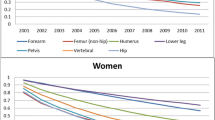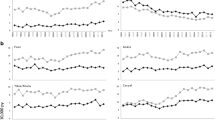Abstract
Summary
We studied the incidence of subsequent fractures in persons of 50+ years from 1990 to 2012 and the relative risk (RR) of subsequent fractures after an index femur/hip fracture, stratified per 5-year age band. Patients suffering a fracture have a high incidence of a subsequent fracture; the RR of subsequent fracture after a femur/hip fracture ranged from 2 to 7.
Introduction
Recent information on the risk of subsequent fractures after a broad range of index fractures in the UK population is scarce. We therefore studied the rates of subsequent fractures of the femur/hip, humerus, radius/ulna, vertebrae, rib, or pelvis after fractures at one of these sites from 1990 to 2012 in 3,156,347 UK men and women aged 50 years or over.
Methods
We undertook a retrospective observational study using the UK Clinical Practice Research Datalink (CPRD). The incidence of subsequent fractures at a specific site was calculated by dividing the observed number of fractures by the number of person-years (py) at risk. The relative risk (RR) of subsequent fractures after a femur/hip fracture, by 5-year age band, was calculated by dividing the incidence of a specific subsequent fracture type by the incidence of first fractures at the same site in the same age group.
Results
The highest subsequent fracture incidence after a femur/hip fracture was for humerus fracture in men (59.5/10.000 py) and radius/ulna fracture in women (117.2/10.000 py). After an index fracture of the radius/ulna, humerus fracture in men (59.3/10.000 py) and femur/hip fracture in women (82.4 per 10.000 py) were most frequent. The RR of fractures after a femur/hip fracture ranged from 2 to 7 and were highest in men and younger age groups.
Conclusion
Patients suffering a fracture have a high incidence of a subsequent fracture. Our findings demonstrate the importance of fracture prevention in patients with a history of a fracture by adequate medical diagnosis and treatment.
Similar content being viewed by others
References
McClung MR, Geusens PPMM, Miller PD et al (2001) Effect of risedronate on the risk of hip fracture in elderly women. N Engl J Med 344:333–340
Marshall D, Johnell O, Wedel H (1996) Meta-analysis of how well measures of bone density predict occurrence of osteoporotic fractures. BMJ 312:1254–1259
Turner DA, Khioe RFS, Shepstone L, Lenaghan E, Cooper C, Gittoes N, Harvey NC, Holland R, Howe A, McCloskey E, O'Neill TW, Torgerson D, Fordham R, SCOOP Study Team (2018) The cost-effectiveness of screening in the community to reduce osteoporotic fractures in older women in the UK: economic evaluation of the SCOOP study. J Bone Miner Res 33(5):845–851
Pasco JA, Seeman E, Henry MJ, Merriman EN, Nicholson GC, Kotowicz MA (2006) The population burden of fractures originates in women with osteopenia, not osteoporosis. Osteoporos Int 17(9):1404–1409
Kanis JA, Johnell O, De Laet C et al (2004) A meta-analysis of previous fracture and subsequent fracture risk. Bone 35(2):375–382
Klotzbuecher CM, Ross Ph D, Landsman PB et al (2000) Patients with prior fractures have an increased risk of future fractures: a summary of the literature and statistical synthesis. JBMR 15(4):721–739
Porthouse J, Birks YF, Torgerson DJ, Cockayne S, Puffer S, Watt I (2004) Risk factors for fracture in a UK population: a prospective cohort study. QJM 97:569–574
Gehlbach S, Saag K, Flahive J et al (2010) GLOW investigators: previous fractures increase risk for subsequent fractures at multiple sites: global longitudinal study of osteoporosis in women. Bone 47:S180
Huntjens KMB, Kosar S, van Geel TACM, Geussens PP, Willems P, Kessels A, Winkens B, Brink P, van Helden S (2010) Risk of subsequent fracture and mortality within 5 years after a non-vertebral fracture. Osteoporos Int 21(12):2075–2082
NICE (2008) Alendronate, etidronate, risedronate, raloxifene, strontium ranelate and teriparatide for the secondary prevention of osteoporotic fragility fractures in postmenopausal women. NICE technology appraisal guidance 161
Compston J, Cooper A, Cooper C, Gittoes N, Gregson C, Harvey N, Hope S, Kanis JA, McCloskey EV, Poole KES, Reid DM, Selby P, Thompson F, Thurston A, Vine N, National Osteoporosis Guideline Group (NOGG) (2017) UK clinical guideline for the prevention and treatment of osteoporosis. Arch Osteoporos 12(1):43
Harvey NC, McCloskey EV, Mitchell PJ, Dawson-Hughes B, Pierroz DD, Reginster JY, Rizzoli R, Cooper C, Kanis JA (2017) Mind the (treatment) gap: a global perspective on current and future strategies for prevention of fragility fractures. Osteoporos Int 28(5):1507–1529
Papaioannou A, Kennedy CC, Ioannidis G, Gao Y, Sawka AM, Goltzman D, Tenenhouse A, Pickard L, Olszynski WP, Davison KS, Kaiser S, Josse RG, Kreiger N, Hanley DA, Prior JC, Brown JP, Anastassiades T, Adachi JD, CaMos Research Group (2008) The osteoporosis care gap in men with fragility fractures: the Canadian multicentre osteoporosis study. Osteoporos Int 19(4):581–587
de Laet CEDH, van der Klift M, Hofman A, Pols HAP (2002) Osteoporosis in men and women: a story about bone mineral density thresholds and hip fracture risk. J Bone Miner Res 17:2231–2236
van Staa TP, Leufkens, Cooper C (2002) Does a fracture at one site predict later fractures at other sites? A Britisch cohort study. Osteoporos Int 13(8):624–629
Hansen L, Petersen KD, Eriksen SA, Langdahl BL, Eiken PA, Brixen K, Abrahamsen B, Jensen J-EB, Harslof T, Vestergaard P (2015) Subsequent fracture rates in a nationwide population-based cohort study with a 10-year perspective. Osteoporos Int 26(2):513–519
Gehlbach S, Saag KG, Adachi JD, Hooven FH, Flahive J, Boonen S, Chapurlat RD, Compston JE, Cooper C, Díez-Perez A, Greenspan SL, LaCroix AZ, Netelenbos JC, Pfeilschifter J, Rossini M, Roux C, Sambrook PN, Silverman S, Siris ES, Watts NB, Lindsay R (2012) Previous fractures at multiple sites increase the risk for subsequent fractures: the global longitudinal study of osteoporopsis in women. J Bone Miner Res 27(3):645–653
Langsetmo L, Goltzman D, Kovacs CS, Adachi JD, Hanley DA, Kreiger N, Josse R, Papaioannou A, Olszynski WP, Jamal SA, the CaMos Research Group (2009) Repeat low-trauma fractures occur frequently among men and women who have osteopenic BMD. J Bone Miner Res 24(9):1515–1522
Bliuc D, Alarkawi D, Nguyen TV, Eisman JA, Center JR (2015) Risk of subsequent fractures and mortality in elderly women and men with fragility fractures with and without osteoporotic bone density: the Dubbo osteoporosis epidemiology study. J Bone Miner Res 30(4):637–646
Gibson-Smith D, Klop C, Elders PJM, Welsing PMJ, van Schoor N, Leufkens HGM, Harvey NC, van Staa TP, de Vries F (2014) The risk of major and any (non-hip) fragility fracture after hip fracture in the UK: 2000-2010. Osteoporos Int 25:2555–2563
van der Velde RY, Wyers CE, Curtis EM, Geussens PPMM, van den Bergh JPW, de Vries F, Cooper C, van Staa TP, Harvey NC (2016) Secular trends in fracture incidence in the UK between 1990 and 2012. Osteoporos Int 27(11):3197–3206. https://doi.org/10.1007/s00198-016-3650-3
Curtis EM, van der Velde RY, Moon RJ, van den Bergh JPW, Geusens PPMM, de Vries F, van Staa TP, Cooper C, Harvey NC (2016) Epidemiology of fractures in the United Kingdom 1988-2012: variation with age, geography, ethnicity and socioeconomic status. Bone 87:19–26
Williams T, van Staa T, Puri S, Eaton S (2012) Recent advances in the utility and use of the general practice research database as an example of a UK primary care data resource. Ther Adv Drug Saf 3(2):89–99. https://doi.org/10.1177/2042098611435911
Walley T, Mantgani A (1997) The UK General Practice Research Database. Lancet 350(9084):1097–1099. https://doi.org/10.1016/s0140-6736(97)04248-7
Herrett E, Gallagher AM, Bhaskaran K, Forbes H, Mathur R, van Staa T, Smeeth L (2015) Data resource profile: clinical practice research datalink (CPRD). Int J Epidemiol 44(3):827–836. https://doi.org/10.1093/ije/dyvD98
Mathur R, Bhaskaran K, Chaturvedi N, Leon DA, vanStaa T, Grundy E, Smeeth L (2014) Completeness and usability of ethnicity data in UK-based primary care and hospital databases. J Public Health (Oxf) 36(4):684–692
Chisholm J (1990) The read clinical classification. BMJ 300:1092
Van Staa TP, Abenhaim L, Cooper C, Zhang B, Leufkens HG (2000) The use of a large pharmacoepidemiological database to study exposure to oral corticosteroids and risk of fractures: validation of study population and results. Pharmacoepidemiol Drug Saf 9:359–366. https://doi.org/10.1002/1099-1557(200009/10)9:5<359::AID-PDS507>3.0.C0;2-E
Khan NF, Harrison SE, Rose PW (2010) Validity of diagnostic coding within the general practice research database: a systematic review. Br J Gen Pract 60(572):e128–e136. https://doi.org/10.3399/bjgp10X483562
Herrett EL, Thomas SL, Smeeth L (2011) Validity of diagnoses in the general practice research database. Br J Gen Pract 61(588):438–439. https://doi.org/10.3399/bjgp11X583092
Johnell O, Oden A, Coulin F, Kanis JA (2001) Acute and long-term increase in fracture risk after hospitalization for vertebral fracture. Osteoporos Int 12(3):207–214
Delmas PD, van de Langerijt L, Watts NB, Eastell R, Genant H, Grauer A, Cahall DL, IMPACT Study Group (2005) Underdiagnosis of vertebral fractures is a worldwide problem: the IMPACT study. J Bone Miner Res 20(4):557–563
Ryg J, Rejnmark L, Overgaard S, Brixen K, Vestergaard P (2009) Hip fracture patients at risk of second hip fracture: a nationwide population-based cohort study of 169,145 cases during 1977-2001. J Bone Miner Res 24:1299–1307
Johansson H, Siggeirsdóttir K, Harvey NC, Odén A, Gudnason V, McCloskey E, Sigurdsson G, Kanis JA (2017) Imminent risk of fracture after fracture. Osteoporos Int 28(3):775–780
Sernbo I, Johnell O (1993) Consequences of a hip fracture: a prospective study over 1 year. Osteoporos Int 3(3):148–153
Curtis JR, Arora T, Matthews RS, Taylor A, Becker DJ, Colon-Emeric C, Kilgore ML, Morrisey MA, Saag KG, Safford MM, Warriner A, Delzell F (2010) Is withholding osteoporosis medication after fracture sometimes rational? A comparison of the risk for second fracture versus death. J Am Med Dir Assoc 11:584–591
Funding
TvS and NCH are joint senior author. The work was supported by a grant from the National Osteoporosis Society. This work was further supported by the Medical Research Council, British Heart Foundation, Arthritis Research UK, International Osteoporosis Foundation, National Institute for Health Research (NIHR) Southampton Biomedical Research Centre, University of Southampton and University Hospital Southampton NHS Foundation Trust, and NIHR Oxford Biomedical Research Centre, University of Oxford.
Author information
Authors and Affiliations
Corresponding author
Ethics declarations
Conflicts of interest
None.
Additional information
T. P. van de Staa and N. C. Harvey are joint senior author
Rights and permissions
About this article
Cite this article
van der Velde, R.Y., Wyers, C.E., Geusens, P.P.M.M. et al. Incidence of subsequent fractures in the UK between 1990 and 2012 among individuals 50 years or older. Osteoporos Int 29, 2469–2475 (2018). https://doi.org/10.1007/s00198-018-4636-0
Received:
Accepted:
Published:
Issue Date:
DOI: https://doi.org/10.1007/s00198-018-4636-0




